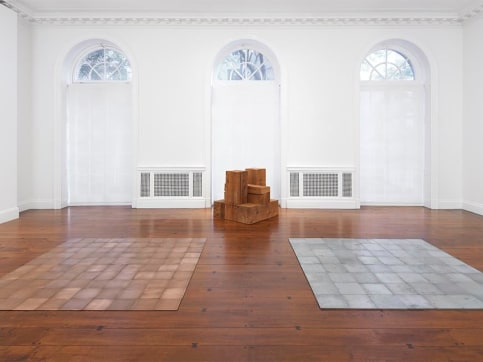
Sol LeWitt was born on September 9, 1928 in Hartford, Connecticut. Celebrated for his wall drawings and structures that explore geometric forms, space, and notions of authorship, LeWitt was introduced to art at a young age, taking art classes at the Wadsworth Atheneum in Hartford. LeWitt received his BFA from Syracuse University in 1949, and was drafted into the Korean War in 1951, where he made posters for the Special Services.
After the war, in 1953, LeWitt moved to New York City, where he studied at the School of Visual Arts and worked as a graphic designer for I.M. Pei’s architecture firm. In 1960, he took an entry-level job at New York’s Museum of Modern Art, where he met Dan Flavin, Robert Ryman, Lucy Lippard, and Robert Mangold, and was introduced to Russian Constructivism and the serial work of Edweard Muybridge. The ideas of seriality put forth by Muybridge and the drive to create a utilitarian art latent in Russian Constructivism would come to inform LeWitt’s work in important ways. Around this time, LeWitt began making three-dimensional structural works (a term he preferred above sculpture) characterized by their open, modular, cubic forms repeated and stacked on top of each other.
LeWitt executed his first wall drawing at Paula Cooper Gallery in 1968. Now his best-known works, the Wall Drawings are comprised of guidelines or simple diagrams conceived by LeWitt. The instructions would then be followed out by a team of assistants directly onto the wall. These Wall Drawings are completed using all manner of media from graphite to crayon, colored pencil, India ink, and acrylic paint. The Wall Drawings are notable in particular for the freedom LeWitt permits in their execution: in addition to not requiring the artist’s hand for their completion, LeWitt allowed them to be installed, removed, and reinstalled in another location as needed.
LeWitt was included in the 1966 “Primary Structures” exhibition at the Jewish Museum in New York, and the important 1969 exhibition “When Attitudes Become Form” at the Kunsthalle Bern. He has been the subject of numerous retrospectives at institutions including the Museum of Modern Art, New York (1978); and the San Francisco Museum of Modern Art; the Museum of Contemporary Art, Chicago; and the Whitney Museum of American Art, New York (2000). Today, his work can be found in the permanent collections of the Tate Modern, London; the Centre Georges Pompidou, Paris; the Solomon R. Guggenheim Museum, New York; the Jewish Museum, New York; the Massachusetts Museum of Contemporary Art, North Adams; and the Hirshhorn Museum and Sculpture Garden, Washington D.C., among others.
Sol LeWitt passed away at the age of 78 on April 8, 2007.